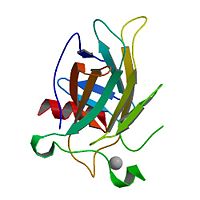Ann Taylor Sandbox 1
From Proteopedia
| |||||||||
| 3d06, resolution 1.20Å () | |||||||||
|---|---|---|---|---|---|---|---|---|---|
| Ligands: | |||||||||
| Gene: | TP53 (Homo sapiens) | ||||||||
| Related: | 3d05, 3d07, 3d08, 3d09, 3d0a | ||||||||
| |||||||||
| |||||||||
| Resources: | FirstGlance, OCA, RCSB, PDBsum | ||||||||
| Coordinates: | save as pdb, mmCIF, xml | ||||||||
Contents |
Human p53 core domain with hot spot mutation R249S (I)
The tumor suppressor protein p53 is mutated in more than 50% of invasive cancers. About 30% of the mutations are found in six major "hot spot" codons located in its DNA binding core domain. To gain structural insight into the deleterious effects of such mutations and their rescue by suppressor mutations, we determined the crystal structures of the p53 core domain incorporating the hot spot mutation , the core domain incorporating R249S and a second-site suppressor mutation H168R (referred to as the double mutant R249S/H168R) and its sequence-specific complex with DNA and of the triple mutant R249S/H168R/T123A. The structural studies were accompanied by transactivation and apoptosis experiments. The crystal structures show that the region at the vicinity of the mutation site in the R249S mutant displays a range of conformations [wild-type (wt) and several mutant-type conformations] due to the loss of stabilizing interactions mediated by R249 in the wt protein. As a consequence, the protein surface that is critical to the formation of functional p53-DNA complexes, through protein-protein and protein-DNA interactions, is largely distorted in the mutant conformations, thus explaining the protein's "loss of function" as a transcription factor. The structure of this region is restored in both R249S/H168R and R249S/H168R/T123A and is further stabilized in the complex of R249S/H168R with DNA. Our functional data show that the introduction of H168R as a second-site suppressor mutation partially restores the transactivation capacity of the protein and that this effect is further amplified by the addition of a third-site mutation T123A. These findings together with previously reported data on wt and mutant p53 provide a structural framework for understanding p53 dysfunction as a result of oncogenic mutations and its rescue by suppressor mutations and for a potential drug design aimed at restoring wt activity to aberrant p53 proteins.
Structural basis of restoring sequence-specific DNA binding and transactivation to mutant p53 by suppressor mutations., Suad O, Rozenberg H, Brosh R, Diskin-Posner Y, Kessler N, Shimon LJ, Frolow F, Liran A, Rotter V, Shakked Z, J Mol Biol. 2009 Jan 9;385(1):249-65. Epub 2008 Oct 30. PMID:18996393
From MEDLINE®/PubMed®, a database of the U.S. National Library of Medicine.
Disease
Known disease associated with this structure: Adrenal cortical carcinoma OMIM:[191170], Breast cancer OMIM:[191170], Colorectal cancer OMIM:[191170], Hepatocellular carcinoma OMIM:[191170], Histiocytoma OMIM:[191170], Li-Fraumeni syndrome OMIM:[191170], Multiple malignancy syndrome OMIM:[191170], Nasopharyngeal carcinoma OMIM:[191170], Osteosarcoma OMIM:[191170], Pancreatic cancer OMIM:[191170], Thyroid carcinoma OMIM:[191170]
About this Structure
3D06 is a 1 chain structure of sequence from Homo sapiens. Full crystallographic information is available from OCA.
Reference
- Suad O, Rozenberg H, Brosh R, Diskin-Posner Y, Kessler N, Shimon LJ, Frolow F, Liran A, Rotter V, Shakked Z. Structural basis of restoring sequence-specific DNA binding and transactivation to mutant p53 by suppressor mutations. J Mol Biol. 2009 Jan 9;385(1):249-65. Epub 2008 Oct 30. PMID:18996393 doi:10.1016/j.jmb.2008.10.063
Page seeded by OCA on Wed Jan 21 10:44:12 2009
Categories: Homo sapiens | Frolow, F. | Rozenberg, H. | Shakked, Z. | Shimon, L J.W. | Suad, O. | Acetylation | Activator | Alternative splicing | Anti-oncogene | Apoptosis | Cell cycle | Covalent protein-rna linkage | Cytoplasm | Disease mutation | Dna-binding | Endoplasmic reticulum | Glycoprotein | Host-virus interaction | Li-fraumeni syndrome | Loop-sheet-helix motif | Metal-binding | Methylation | Mutant protein | Nucleus | P53 | Phosphoprotein | Polymorphism | Transcription | Transcription regulation | Ubl conjugation | Zinc


